
Dallas Texas

 |
Dallas Texas |
 |
| Dallas, Texas. Located on the Trinity River, Dallas is the seat of Dallas County and also lies partly in Collin, Denton, and Kaufman counties. The third largest city in Texas (after Houston and San Antonio) and the ninth largest city in the United States in 1998, Dallas is the center of the largest consolidated metropolitan area in the state. Historically, Dallas has been the transportation and marketing center for the north Texas area. It has evolved into a major center of finance, commerce, trade, and manufacturing for the southwestern United States and Mexico. The terrain is mostly flat and drains into the Trinity River. The climate is continental, with hot summers and moderately cold winters. The city was probably named for George Mifflin Dallas, vice president of the United States (1845-1849), although the exact origin of the name is undetermined and historians have also suggested his brother, Commodore Alexander J. Dallas of the United States Navy, and Joseph Dallas, who settled in the area in 1842, as possible namesakes for the city. |
|
|
The city of Dallas extends over a land area of 341.9 sq mi. The Dallas metropolitan area is made up of the counties of Collin, Dallas, Denton, Ellis, Henderson, Hunt, Kaufman, and Rockwall. City-owned greenbelts parallel
White Rock Creek,
Turtle Creek, and the
Trinity River. In addition to Dallas, cities with more than 100,000 in population in the area are Garland, Irving, Mesquite, and Plano. Dallas is also part of the Dallas/Fort Worth Consolidated Metropolitan Statistical Area, also known as the Metroplex. In addition to Dallas and Fort Worth, the Metroplex includes Arlington and more than 80 other towns and communities. The city of Dallas has sprawled into nearby counties, growing primarily to the north and west. The downtown is known for its distinctive contemporary architecture. Near the commercial center of the city is the West End Historic District, a group of 19th-century warehouses converted into shops and restaurants. Also nearby is the Deep Ellum (Elm) area, which was a thriving center of businesses owned by black Americans from the time of the Civil War (1861-1865) until the 1930s. This neighborhood now contains clubs, restaurants, and galleries. |
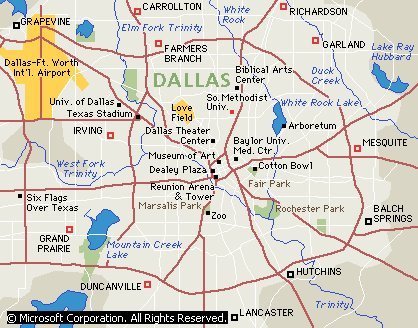
|
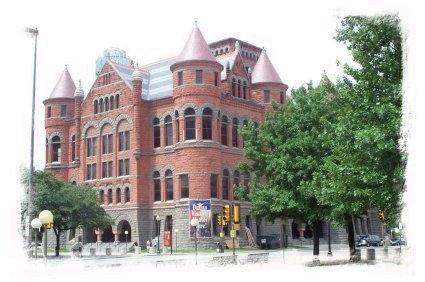 |
The city's historic sites include
Fair Park, the largest art deco art and architecture district in the world and a National Historic Landmark, located east of downtown; and
Dealey Plaza, the site of the assassination in 1963 of President John F. Kennedy and a National Historic Landmark District, located downtown. Other sites are the
John F. Kennedy Memorial, designed by American architect Philip C. Johnson; the former county courthouse, designed in the Romanesque architectural style; the present courthouse and downtown library, designed by Chinese American architect I. M. Pei; the Sixth Floor of the former Texas School Book Depository, from which Lee Harvey Oswald allegedly shot Kennedy; and
Old City Park, the site of Dallas's oldest public park and now a museum of the architectural and cultural history of the city and region. |
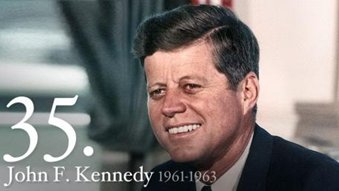 President John F. Kennedy |
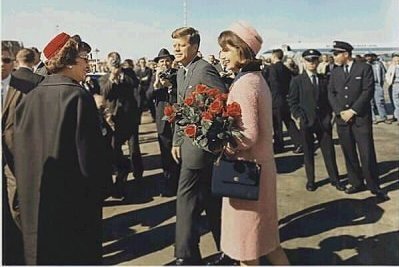
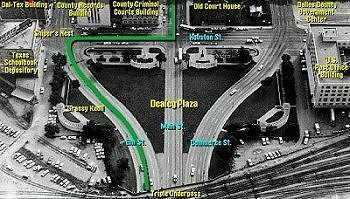 |
| The Dallas area suffered an economic downturn in the 1980s, but it rebounded in the 1990s, posting the strongest employment growth in the state in 1994. The city has a diversified economic base. Service industries, including trade, make up the city's most important economic sector, followed by manufacturing. Dallas remains an important distribution, financial, and insurance center of the Southwest. It is the site of a district
Federal Reserve bank and the headquarters of a number of federal regional offices and large insurance and oil companies. Among the area's most important manufactures are technology-related products, including computers, biomedical products, and electronics. Dallas has the largest concentration of trade facilities in the South and Southwest. Its location in the north central part of the state and its dense network of railroads and highways enable it to serve as the shipping center for the
agricultural and mineral products of the surrounding region, including
cotton, cereals,
livestock, fruit, petroleum, and
natural gas. |
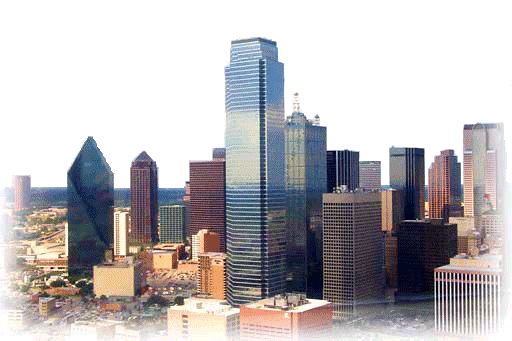 |
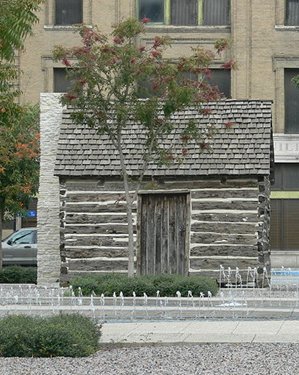 |
French traders had contact with the Anadarko people in the area around Dallas in the 1700s. In 1841
John Neely Bryan founded a trading post on the east bank of the
Trinity River, near the junction of two Native American trails. Bryan was unaware that he had settled on land granted by the Texas republic to an immigration company, but he eventually legalized his claim. The extensive promotion efforts of the company brought settlers to the area, and in 1844 a townsite was laid out. The town was incorporated in 1856, and in the late 1850s, the collapse of a nearby cooperative community, La Réunion, augmented the population and added skilled European craftspeople to the workforce.
In March 1861 Texas seceded from the Union and joined the Confederate States of America. During the American Civil War (1861-1865), Dallas served as a supply and storage post for the state. After the war ended, freed slaves flocked to Texas and founded a freedmen's town on the outskirts of Dallas. By 1870, the year Texas was readmitted to the Union, Dallas had a population of about 3000. |
|
Dallas grew steadily for the next 30 years. The successful lobbying for two
railroads, the Houston and Texas Central in 1872 and the Texas and Pacific in 1873, initiated this growth. As a rail crossroads, Dallas became a regional transport center for products headed to Northern and Eastern manufacturing centers. Cotton became the principal source of income, but the city also attracted merchants and banking and insurance companies eager to exploit available transportation and communication facilities. Throughout this period, business and political leaders forged close ties, thus shaping the character of the city and guiding its economic direction. By 1890 Dallas had 38,067 residents and was the largest city in the state. |
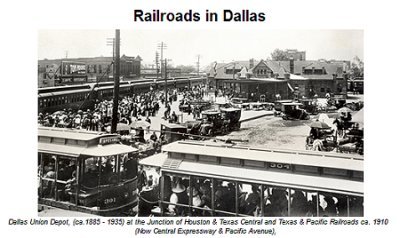 |




